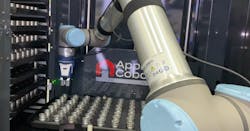The automation of machine tending processes is one of the faster growing applications for cobots across industry, particularly in small to mid-sized manufacturing operations. One of the newest entrants into this field is PBC Linear, a company more well-known for its linear motion components and mechatronic actuators.
Speaking with Chris Parish, business development manager for PBC Linear’s Applied Cobotics, he said the Cobot Feeder was initially developed internally about three years ago for PBC Linear’s own production operations. Prior to the development of the Cobot Feeder, workers would be required to fill part trays every 30 minutes to an hour. Confronted with the same labor issues facing the manufacturing industry in general, PBC Linear decided to automate these manual machine tending tasks.
See video below of the Cobot Feeder demo from Automate 2023.
According to PBC Linear, the Cobot Feeder provides a standardized platform for storing, staging and safely delivering parts into a position where they can be consistently loaded and unloaded with a cobot. The company noted its experience with cobots taught them that using a single tray of parts with a cobot did not take advantage of the cobot’s potential because operators might get called away to do other tasks, resulting in cobot downtime. They also found that vision systems for picking parts from a bin were not always as reliable as they needed them to be in various operating conditions.
Safety systems on the Cobot Feeder include a built-in safety interlock system on the dunnage rack and three light curtains to guard the robot access window, protect objects under the robot and protect the gap left when the rack is removed.
“We wanted a solution that would be completely lights out” with the capacity for up to three shifts, said Parish. “Because we have built machines similar to this in the past, and because we offer high-precision linear motion products, we decided to come up with a solution for ourselves, which is our new Cobot Feeder. Instead of having one part tray [prepared by a worker] for a robot to interact with, [this system] is pulling from 17 different trays, which means we can load up to 1,000 of our linear bearings on a Friday and those parts will be completed by Monday morning.”
The Cobot Feeder features a central lift table that raises and lowers to pull part trays from a dunnage rack tower and then places them in a repeatable position for the cobot. A vertical lead screw-driven shelf and a horizontal tray loader/unloader provide accurate and repeatable motion in the Cobot Feeder, eliminating the need for a worker to remove and reload material from the cobot work zone.
Noting that the Cobot Feeder is “a portable, out-of-the-box system for high-volume, high-mix manufacturing applications,” Parish said the Cobot Feeder had just received Universal Robots partner certification (UR+) a few weeks prior, helping to establish the Cobot Feeder in the market with a well-known cobot supplier.
PBC Linear says programming coordinates between the cobot feeder and cobot is “a simple process through an HMI or with the PBC Linear UR Cap (which enables use of Universal Robots’ interface).”
The Cobot Feeder, which runs on 220V single phase power, includes a base storage and retrieval unit with cobot stand, enclosed steel rack dunnage tower with a 17-tray capacity that can store up to 50 lbs. of material, a Mitsubishi HMI touch screen display for lift control, as well as EtherNet/IP, Modbus and standard UR cobot communications. The cobot and gripper are not included, but the system is compatible with Universal Robots’ UR5e, UR10e, UR16e and UR20.
Safety systems on the Cobot Feeder include a built-in safety interlock system on the dunnage rack and three light curtains to guard the robot access window, protect objects under the robot and protect the gap left when the rack is removed.
In the video below, Chris Parish demonstrates PBC Linear’s Cobot Feeder.
Leaders relevant to this article:


